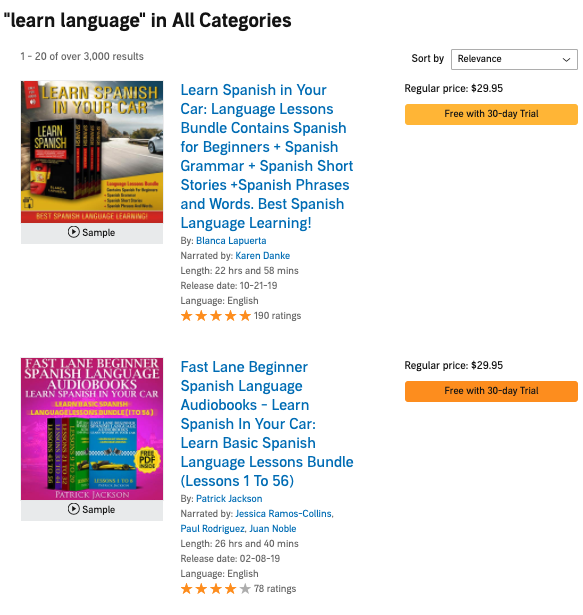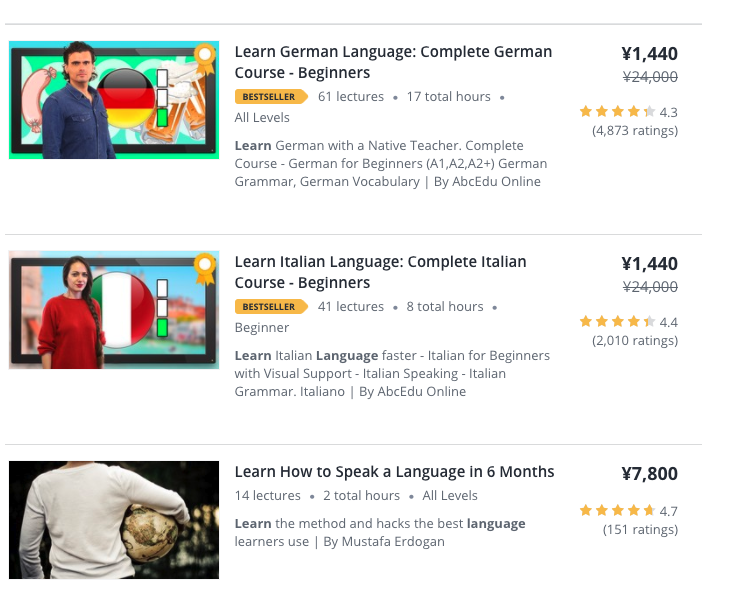Are you thinking about… how to learn a language at home?
I mean, can you even learn at home?
Yes you can. There are a ton of language learning resources — both digital and physical — you can use to learn a new language at home. Will they get you speaking a new language? Yes. Are they miracle programs? No. Whether you choose an online tutor or a language learning program, all work…if you use them.
So, if you’re interested in learning a language…
Here are the 10 best ways for how to learn a language at home.

1. Self Learning Programs
Online learning programs teach you in various ways: audio lessons, video lessons, quizzes and help you learn faster with study tools like flashcards.
How do they work exactly? They teach you. They give you lesson 1, lesson 2, and so on. They quiz you to improve your memory. And they guide you until you master a new language.
So, if you want to learn a language at home… on your own… at your own pace…without pressure or tight schedules, you should get a program.
- Innovative Language – These guys teach 34 languages from Arabic to Japanese down to Vietnamese.
- How will you learn though? Pick a language.
- You learn with Audio & Video lessons by language teachers
- Good for speaking and learning conversations.
- Just press play to learn and listen or watch.
- Lessons are just 3-15 minutes in length.
- You get lesson notes to read along and review with.
- They guide you from lesson 1 to 2 to 3… with progress tools.
- You can learn on any device: computer, smartphone, or tablet.
- You also get study tools (flashcards, conversation tracks, speaking practice, conversation breakdowns) to help you learn words, phrases, and conversations faster.
- Click here to pick a language and get your Free Lifetime Account.
- Rosetta Stone – Rosetta is well known for their quiz approach to learning languages. Their goal is to teach you through immersion like a child would. So, you have to pair up words with the pictures that match them best.
- Quiz-like approach and matching games
- Accent practice
- Learn on any device: computer or smartphone.
- Live tutoring
- DuoLingo – They are another quiz-based learning program and are a very popular app. How do you learn? Through quizzes, games, and translation.
- Quiz-like, interactive approach to learning
- Keeps you motivated with streaks and reminders.
- Learn on any device: computer or smartphone.
- Good for learning words and improving your vocabulary.
2. Online Tutors
Now, if you’ve been learning on your own but finally want to practice…
Or, if you just prefer a more personal touch and access to a native, then you’ll want a tutor. Where can you get them?
- iTalki.com: They are a marketplace for online language tutors and teachers. The good part is, there are a lot of teachers and price ranges to choose from. So, you can always research before settling on someone. Prices can be very cheap.
- How do you learn? You learn by video chatting with a native. Buy time with a teacher. The teacher will do the rest.
3. Audiobooks
Instead of reading a textbook…
Why not just listen to someone read one to you!?
That’s how audiobooks work. So, you can just press play and listen to someone speak gentle foreign words into your ears.
- How do you learn with Audiobooks? Just listen, speak out-loud and re-listen for review.
- Strength: Easy to consume. Improves your listening skills. Repeat out loud to practice speaking.
You can get language phrasebooks at Audible.com (Amazon’s Audiobook store) or on the Apple Store.

4. Udemy
Udemy is an online marketplace for video courses. So, if you want to buy a course on a certain topic and learn… this is the place. And yes, it includes languages.

Now, quality varies because they let individuals sign up and offer their courses. So, you might want to shop around and read the reviews.
- How do you learn? Just go from video 1 to video 2 to video 3…and so on.
- Strengths: Good for listening skills. Good for learning grammar if the concepts are explained and illustrated on screen.
My only complaint is, unlike learning programs, you don’t get various tools to help you review information. You just passively take in the language (watch videos) but it’s on YOU to keep notes, review, and practice the language.
Go to Udemy.com.
5. Phrasebooks
If you’re brand new to a language and want a gentle introduction…
Get a phrasebook. Why? Because you simply learn the most common phrases and start speaking. And you learn just by going from page to page and picking new phrases. That’s it.
Phrasebooks are meant for travelers who have no time for grammar. But they’re also great resources for beginners who just want to add foreign words to their brain.
- How do you learn? Read. Take notes. Read out-loud to practice speaking. Copy out words into a notebook to commit them to your memory.
- Strength: You learn and start speaking the most common phrases. Very easy to consume and skips the “hard work” of learning grammar.
You can get language phrasebooks at Amazon.com.
6. Textbooks
Now, let’s say you want something a bit more serious than a phrasebook.
Let’s say you want to learn reading, writing, grammar, basic conversations… AND have a strong foundation of the language.
Then, you should get a textbook.
Mind you, textbooks aren’t always fun to read and you WILL need to hunker down and concentrate. But, all learning requires, that anyway, right?
- How do you learn? Read. Take notes. Do the exercises inside the book. Read out loud to practice speaking. Copy out words, grammar rules and dialog to 1) practice writing and 2) commit them to your memory.
- Strength: You get a solid foundation of the language. You learn how to read, write, and pick up basic words, phrases and grammar rules.
You can get these on Amazon.com.
7. Alexa
Learning with Alexa is not high on my “how to learn a language at home” list. Why?
Because the technology is new. You speak at Alexa and give it a command. Then, it answers you. But that’s as far as it goes. It won’t quiz you. It’s not smart enough yet.
So, the big benefit is… playing audio lessons in the background, as you do things around the house.
- How do you learn languages? Just listen and repeat along.
- Strength: Easy to consume. Improves your listening skills.
Click here to check out Amazon Alexa skills.
You can also check out my other guide: How to Learn Language with Alexa & Amazon Echo.
8. Podcasts
Podcasts are another simple way to learn languages.
You just press play and listen to a podcast, where a teacher exposes you to the language.
The downside is… more often than not… these are not serious language resources, so they may not push the needle too far on your language learning. Podcasts are entertaining and making use of “dead” time, but they shouldn’t be your main source of learning.
- How do you learn languages? Just listen and repeat along.
- Strength: Easy to consume. Improves your listening skills.

9. YouTube
I’ll say the same for YouTube as I did for Podcasts: good to watch in your spare time, but not a serious tool, and should not be your main source. Unless you’re a genius who absorbs words after hearing them just once.
The other big downside is… YouTube is incredibly good at distracting you with OTHER videos to watch. So, if you start with a Spanish or French lesson, 4 minutes later you’ll end up watching cat videos and pimple popping operations. So much for learning a foreign language at home.
Now that I got the negatives out the way… there’s nothing wrong with watching YouTube in your free time. There are some great language teachers on there.
- How do you learn languages? Watch videos.
- Strength: Improves your listening skills.
9. Music
Music is also not a very serious study tool BUT…
Music has something that makes it powerful. The catchiness of it. The repetition. So, if you find songs that you like in your target language, you will remember them after a few listens.
This is a good way to keep learning fun… because we can only spend so much time with a textbook before our brain dries up.
- How do you learn languages? Just listen and repeat along.
- Strength: Easy to consume. Improves your listening skills.
Where can you find music in other languages? YouTube. Just search for Spanish music, Italian music, Japanese music, and go to town.
10. Shows & Movies
Next up on the “how to learn a language at home” the fun way… are shows and movies.
I want to say that shows and movies are also not a serious way to learn BUT…
I’ve met many English learners who literally learned from American TV shows.
So, it really depends on you. If you’re watching for entertainment and nothing else, you won’t get much out of it. But, if you’re repeating lines, rewinding, taking notes and reviewing…. yes, you probably will learn the language.
- How do you learn languages? Watch videos.
- Strength: Improves your listening skills. Improves speaking skills if you repeat what you hear.
Where can you find shows and movies in other languages? YouTube. Or Netflix.
11. Sticky Notes.
One fun way to learn a new language at home is… to label things around your house with sticky notes. So, if you’re learning Spanish, write the Spanish word for “table” and stick it on your table. Do the same for “computer,” “tv,” “couch” and whatever else you can.
Then, with enough exposure, these words will be stuck in your head.
Of course, you just have to decide whether you want to cover your home in sticky notes first.
- How do you learn languages? Post sticky notes around home and remember words.
- Strength: Learning and memorizing words.
Now, you now how to learn a language at home.
And why not learn at home?
- It’s comfortable.
- You don’t have to go anywhere.
- You can learn from a textbook or on your computer/phone.
- You can still get access to real teachers if you want.
- And, you can wear your Batman pajamas.
If you have any other methods of learning languages at home, leave a comment.
The Main Junkie
P.S. I recommend Innovative Language’s Audio/Video lessons. Very easy to consume. They focus on real conversations. So, with a quick 5 minute lesson, you come away knowing a practical conversation and all of the words inside. One conversation per lesson. You could theoretically master and speak 100 “dialogs” with a 100 lessons.
Click here to pick a language and get your free lifetime account.
